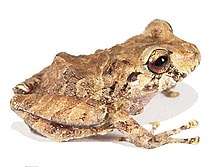Pristimantis mallii
Pristimantis mallii is a species of frog in the family Craugastoridae. It is endemic to Ecuador.[2][3] Described in 2019,[1] it is only known from the Río Zuñag Reserve on the eastern slope of the Andes, in the upper basin of the Pastaza River.[2][3] The specific name mallii honors V. N. Mallikarjuna "Malli" Rao, winner of Lavoisier Medal who helped develop an environmentally safe alternative to the fluorocarbons and whose donation helped establish the Río Zuñag Reserve.[1] Common name Malli's rain frog has been coined for this species.[1][2][3]
| Pristimantis mallii | |
|---|---|
 | |
| Pristimantis mallii, mature female | |
| Scientific classification | |
| Kingdom: | Animalia |
| Phylum: | Chordata |
| Class: | Amphibia |
| Order: | Anura |
| Family: | Craugastoridae |
| Genus: | Pristimantis |
| Species: | P. mallii |
| Binomial name | |
| Pristimantis mallii Reyes-Puig, Reyes-Puig, Velarde-Garcéz, Dávalos, Mancero, Navarrete, Yánez-Muñoz, Cisneros-Heredia, and Ron, 2019[1] | |
 | |
| Pristimantis mallii is only known from the Río Zuñag Reserve in the Andes of Ecuador | |
Description
Adult males measure 12–21 mm (0.5–0.8 in) and adult females 23–43 mm (0.9–1.7 in) in snout–vent length. The snout is broadly rounded in dorsal view. The tympanum is visible, albeit slightly covered by the supratympanic fold. The fingers have narrow lateral fringes and terminal discs. The toes have slightly defined lateral fringes and terminal discs; no webbing is present. The upper eyelids bear 1–2 subconical tubercles and some rounded tubercles. Skin on the dorsum and flanks is shagreen. Scapular folds are distinctive. The dorsum and flanks light are brown to brown. There are irregular dark brown marks bounded by dirty or greenish cream or light brown. The groin has irregular yellowish marks. The venter is light gray or cream, spotted with brown. The iris is golden coppery with black reticulations and a reddish horizontal stripe.[1][3]
Habitat and conservation
Pristimantis mallii is known from the montane cloud forests of the east-central slope of the Andes at elevations of 1,300–2,190 m (4,270–7,190 ft) above sea level. All specimens were found in herbaceous and shrub vegetation inside mature forest some 1.5–4 m (4 ft 11 in–13 ft 1 in) above the ground.[1][3]
The Río Zuñag Reserve is located in the buffer zone of the Llanganates National Park.[1]
References
- Reyes-Puig, Carolina; Reyes-Puig, Juan Pablo; Velarde-Garcéz, Daniel A.; Dávalos, Nicolás; et al. (2019). "A new species of terrestrial frog Pristimantis (Strabomantidae) from the upper basin of the Pastaza River, Ecuador". ZooKeys. 832: 113–133. doi:10.3897/zookeys.832.30874.
- Frost, Darrel R. (2019). "Pristimantis mallii Reyes-Puig, Reyes-Puig, Velarde-Garcéz, Dávalos, Mancero, Navarrete, Yánez-Muñoz, Cisneros-Heredia, and Ron, 2019". Amphibian Species of the World: an Online Reference. Version 6.0. American Museum of Natural History. Retrieved 7 July 2019.
- Carrión J. C. (2019). Ron, S. R.; Merino-Viteri, A. & Ortiz, D. A. (eds.). "Pristimantis mallii". Anfibios del Ecuador. Version 2019.0. Museo de Zoología, Pontificia Universidad Católica del Ecuador (QCAZ). Retrieved 7 July 2019.